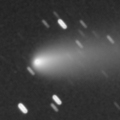
|
Now it is so bright as 9.5 mag (Jan. 13, Juan Jose Gonzalez). It keeps as bright as 9-10 mag for a long time until spring. It will be observable in good condition for a long time after this in the Northern Hemisphere. It keeps visible visually for one year until autumn.
Date(TT) R.A. (2000) Decl. Delta r Elong. m1 Best Time(A, h)
Jan. 23 14 26.53 34 51.6 2.204 2.561 99 9.4 3:30 (214, 10)
Jan. 30 14 37.75 37 53.8 2.194 2.599 102 9.5 3:40 (208, 10)
|
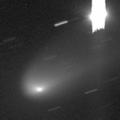
|
Now it is so bright as 9.7 mag (Jan. 13, Juan Jose Gonzalez). It keeps observable bright as 9-10 mag in a good condition for a long time until spring. It keeps observable until autumn when it fades down to 16 mag.
Date(TT) R.A. (2000) Decl. Delta r Elong. m1 Best Time(A, h)
Jan. 23 12 56.92 -3 52.1 1.025 1.627 108 10.0 3:30 (215, 54)
Jan. 30 13 10.68 -4 47.6 0.967 1.615 111 9.9 3:40 (206, 57)
|
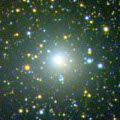
|
It reached up to 7.7 mag in summer (Aug. 13, Chris Wyatt). It is fading now. It has already faded down to 10.2 mag (Dec. 11, Carlos Labordena). Now it is not observable. In the Southern Hemisphere, it will appear in the morning sky in late February, then it keeps observable for a long time. But in the Northern Hemisphere, it is only observable in the low sky in spring, then it will never be observable again.
Date(TT) R.A. (2000) Decl. Delta r Elong. m1 Best Time(A, h)
Jan. 23 19 51.76 -20 9.8 4.645 3.669 6 10.7 3:30 (306,-13)
Jan. 30 19 56.01 -20 47.1 4.657 3.704 12 10.8 3:40 (301, -7)
|
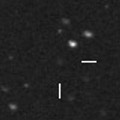
|
Appearing in the morning sky, brighter than expected. Now it is 12.1 mag (Jan. 26, Ken-ichi Kadota). It will reach up to 8 mag and to be observable in good condition in spring.
Date(TT) R.A. (2000) Decl. Delta r Elong. m1 Best Time(A, h)
Jan. 23 18 8.68 -21 29.1 2.745 1.965 30 11.8 3:30 (292, 6)
Jan. 30 18 17.41 -19 12.2 2.610 1.902 35 11.5 3:40 (286, 11)
|
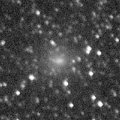
|
It reached up to 8.4 mag in October (Oct. 20, Marco Goiato). Now it is fading. But it is bright as 10.5 mag still now (Jan. 11, Carlos Labordena). In the Northern Hemisphere, it keeps observable in the low sky until February when it fades down to 13.5 mag.
Date(TT) R.A. (2000) Decl. Delta r Elong. m1 Best Time(A, h)
Jan. 23 22 48.65 -10 25.6 2.425 1.742 36 12.0 20:52 ( 80, 3)
Jan. 30 23 6.49 -8 28.2 2.505 1.785 34 12.4 20:45 ( 81, 2)
|
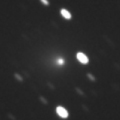
|
Now it is bright as 11.5 mag (Jan. 12, Juan Jose Gonzalez). In the Northern Hemisphere, it keeps observable in good condition until spring.
Date(TT) R.A. (2000) Decl. Delta r Elong. m1 Best Time(A, h)
Jan. 23 5 41.54 11 56.8 1.126 1.991 141 12.2 21:31 (180, 43)
Jan. 30 5 42.38 12 55.0 1.176 1.996 134 12.4 21:04 (180, 42)
|
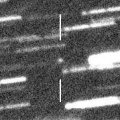
|
Appearing in the morning sky, brighter than expected. Now it is 13.2 mag (Jan. 24, Ken-ichi Kadota). It will brighten rapidly after this, and will be bright as 8 mag in the northern sky in March and April. In the Southern Hemisphere, it will be observable in the low sky after the perihelion passage only.
Date(TT) R.A. (2000) Decl. Delta r Elong. m1 Best Time(A, h)
Jan. 23 19 40.41 3 46.2 2.166 1.344 25 13.2 3:30 (286,-27)
Jan. 30 19 48.97 6 7.0 2.020 1.242 28 12.7 3:40 (279,-23)
|

|
Outbursts occured repeatedly since September, and it keeps visible visually. It is bright as 12.0 mag still now (Dec. 12, Juan Jose Gonzalez).
Date(TT) R.A. (2000) Decl. Delta r Elong. m1 Best Time(A, h)
Jan. 23 9 43.74 11 58.0 5.263 6.189 158 13.5 1:36 (180, 43)
Jan. 30 9 40.68 12 7.6 5.229 6.191 166 13.5 1:06 (180, 43)
|
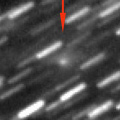
|
It became very bright and observed visually as 9.2 mag (Nov. 18, Juan Jose Gonzalez) and 11.6 mag (Dec. 7, Chris Wyatt) until around the perihelion passage. In January, it approached to the earth down to 0.2 A.U. In the Southern Hemisphere, it is observable in the excellent condition. But it is fading rapidly now. Now it is 15.0 mag (Jan. 26, Yasukazu Ikari). It will be fainter than 18 mag in March.
Date(TT) R.A. (2000) Decl. Delta r Elong. m1 Best Time(A, h)
Jan. 23 9 33.01 -36 4.4 0.226 1.120 121 13.6 1:27 ( 0, 88)
Jan. 30 9 8.13 -22 0.0 0.275 1.208 139 14.3 0:34 (180, 78)
|
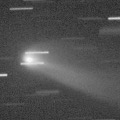
|
An outburst occured on Oct. 13, and it reached up to 8.5 mag on Oct. 15 (Toru Yusa). The central nucleus shined like a bright star, and the dust coma looked like 17P/Holmes in outburst. However, the comet returned to the normal state within a few days. Now it is 13.0 mag (Jan. 15, Carlos Labordena). It will fade out rapidly, and will be fainter than 14 mag in late January. In the Northern Hemisphere, it keeps observable in good condition for a long time until spring when it becomes fainter than 18 mag.
Date(TT) R.A. (2000) Decl. Delta r Elong. m1 Best Time(A, h)
Jan. 23 5 31.14 13 53.7 1.174 2.024 139 13.9 21:20 (180, 41)
Jan. 30 5 32.37 15 15.1 1.283 2.082 132 14.3 20:54 (180, 40)
|

|
Appearing in the morining sky. It will brighten up to 12-13 mag in summer. But it locates somewhat low in the Northern Hemisphere.
Date(TT) R.A. (2000) Decl. Delta r Elong. m1 Best Time(A, h)
Jan. 23 17 47.40 -24 8.9 3.184 2.452 35 14.0 3:30 (291, 12)
Jan. 30 18 1.94 -24 28.8 3.128 2.448 39 13.9 3:40 (289, 16)
|
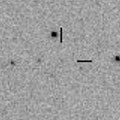
|
Now it is 15.6 mag (Dec. 6, A. Maury, J. B. de Vanssay, F. Mallia, F. Kugel). It will be 14 mag from winter to spring in 2010. But the condition is bad. Now it is not observable. In the Northern Hemisphere, it will appear in the morning sky at 15 mag in late May, then it keeps observable while fading gradually after that.
Date(TT) R.A. (2000) Decl. Delta r Elong. m1 Best Time(A, h)
Jan. 23 22 17.06 -21 17.6 2.560 1.746 27 14.2 20:52 ( 67, 3)
Jan. 30 22 31.12 -17 52.5 2.583 1.733 24 14.1 20:45 ( 68, 0)
|
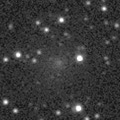
|
Now it is bright as 13.5 mag (Jan. 16, Michael Jager). Very faint large coma is visible in the excellent condition. However, the central nuclear is so faint as 17 mag.
Date(TT) R.A. (2000) Decl. Delta r Elong. m1 Best Time(A, h)
Jan. 23 0 52.73 42 37.4 1.324 1.625 88 14.8 20:52 (139, -6)
Jan. 30 0 51.26 44 43.1 1.356 1.579 83 14.6 20:45 (138,-11)
|

|
It brightened up to 11 mag in spring and summer in 2009. Appearing in the morninig sky again. It keeps observable after this until autumn when it becomes fainter than 18 mag while fading gradually. But it locates somewhat low in the Northern Hemisphere.
Date(TT) R.A. (2000) Decl. Delta r Elong. m1 Best Time(A, h)
Jan. 23 17 52.27 -25 41.8 3.278 2.529 34 14.7 3:30 (293, 12)
Jan. 30 18 5.77 -25 47.8 3.247 2.552 38 14.8 3:40 (290, 16)
|
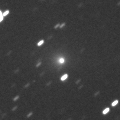
|
Now it is 13.4 mag, already visible visually (Dec. 24, Marco Goiato). It will be observable at 15 mag in good condition in winter and spring.
Date(TT) R.A. (2000) Decl. Delta r Elong. m1 Best Time(A, h)
Jan. 23 4 49.43 16 48.6 1.252 2.031 130 15.0 20:52 (176, 38)
Jan. 30 4 50.78 17 39.1 1.290 2.009 123 15.0 20:45 (170, 37)
|
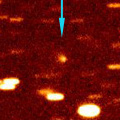
|
It had been brightening as expected until Dec. 29 when it was 16.4 mag (Ken-ichi Kadota). However, it was reported bright as 14.2 mag on Jan. 3 (W. Hasubick). Maybe an outburst. The condition of this apparition is bad. It will reach up to 11-12 mag from spring to autumn in 2010, but it is not observable. It will be getting brighter gradually in the evening sky, but it will be too low to observe in January at 15 mag.
Date(TT) R.A. (2000) Decl. Delta r Elong. m1 Best Time(A, h)
Jan. 23 22 18.05 1 54.9 2.861 2.145 36 15.4 20:52 ( 85,-10)
Jan. 30 22 31.35 2 51.1 2.859 2.097 32 15.2 20:45 ( 85,-12)
|

|
It will approach to the sun down to 0.4 A.U. in July, and it is expected to reach up to 4 mag. It keeps unobservable for a while. It will appear in the morning sky at 12 mag in April. In the Northern Hemisphere, it is observable only until June.
Date(TT) R.A. (2000) Decl. Delta r Elong. m1 Best Time(A, h)
Jan. 23 21 21.66 -19 37.0 3.844 2.902 14 15.6 20:52 ( 59, -8)
Jan. 30 21 28.25 -18 28.0 3.776 2.809 9 15.4 20:45 ( 58,-11)
|

|
Now it is 17.1 mag (Jan. 24, Yasukazu Ikari). It was expected to be observable at 15 mag in good condition from winter to spring. But actually, it is much fainter than expected.
Date(TT) R.A. (2000) Decl. Delta r Elong. m1 Best Time(A, h)
Jan. 23 10 40.53 18 42.2 1.397 2.286 146 15.5 2:33 (180, 36)
Jan. 30 10 38.72 19 20.8 1.350 2.277 154 15.4 2:04 (180, 36)
|

|
It brightned up to 10 mag from late 2008 to early 2009. Now it is fading. But it is still bright as 16.2 mag (Dec. 30, Ken-ichi Kadota). It keeps observable in good condition at 16 mag for a while.
Date(TT) R.A. (2000) Decl. Delta r Elong. m1 Best Time(A, h)
Jan. 23 10 14.64 3 15.2 4.621 5.478 147 15.4 2:07 (180, 52)
Jan. 30 10 10.86 3 13.3 4.623 5.532 155 15.4 1:36 (180, 52)
|
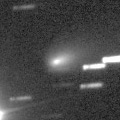
|
It brightened much faster than expected. It became very bright visually at 11.8 mag in December (Dec. 12, Juan Jose Gonzalez). But it is fading rapidly now. It has already faded down to 15.2 mag (Jan. 10, Ken-ichi Kadota). It keeps observable in good condition for a long time. But it will be fainter than 18 mag in late February.
Date(TT) R.A. (2000) Decl. Delta r Elong. m1 Best Time(A, h)
Jan. 23 10 41.23 12 27.4 0.584 1.502 145 15.4 2:33 (180, 43)
Jan. 30 10 40.53 14 49.0 0.594 1.539 153 15.9 2:05 (180, 40)
|
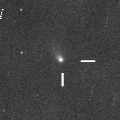
|
It brightened very rapidly. Now it is 14.8 mag and visible visually (Dec. 4, Juan Jose Gonzalez). It is observable at 15 mag in good condition in winter.
Date(TT) R.A. (2000) Decl. Delta r Elong. m1 Best Time(A, h)
Jan. 23 2 51.26 -7 59.3 1.381 1.759 94 15.6 20:52 (124, 50)
Jan. 30 3 4.53 -7 46.0 1.444 1.766 91 15.7 20:45 (123, 48)
|
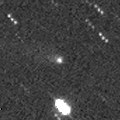
|
Now it is 16.7 mag (Jan. 15, Ken-ichi Kadota), a bit fainter than this ephemeris. It will be observable at 16 mag in good condition until spring.
Date(TT) R.A. (2000) Decl. Delta r Elong. m1 Best Time(A, h)
Jan. 23 15 38.70 21 48.3 3.046 3.038 80 15.7 3:30 (235, 9)
Jan. 30 15 34.63 22 28.1 2.961 3.067 86 15.7 3:40 (227, 16)
|

|
Now it is 16.6 mag (Jan. 15, Ken-ichi Kadota). It was observed as 15-16 mag in early 2009. In 2010, it will be observable at 16 mag in good condition from winter to spring.
Date(TT) R.A. (2000) Decl. Delta r Elong. m1 Best Time(A, h)
Jan. 23 13 52.72 -4 42.5 3.392 3.610 94 15.8 3:30 (234, 47)
Jan. 30 13 55.96 -4 51.6 3.293 3.614 101 15.7 3:40 (223, 52)
|
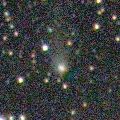
|
It brightened up to 11.5 mag in 2008 summer (Aug. 4, Marco Goiato). Now it is 15.8 mag (Dec. 18, A. Novichonok, A. Smirnov, S. Plaksa). It keeps observable in good condition for a long time in the Southern Hemisphere. Now it became observable again also in the Northern Hemisphere. It will keep 15-16 mag until spring.
Date(TT) R.A. (2000) Decl. Delta r Elong. m1 Best Time(A, h)
Jan. 23 4 43.95 -33 21.3 4.639 5.003 106 15.8 20:52 (113, 86)
Jan. 30 4 40.37 -31 42.1 4.749 5.055 102 15.9 20:45 (108, 80)
|
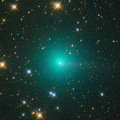
|
It brightened up to 6.7 mag in June (June 9, Marco Goiato). Now it is 15.2 mag (Jan. 15, Ken-ichi Kadota). A bit brighter than this ephemeris. It will be fading after this, and keeps observable until spring when it becomes fainter than 18 mag.
Date(TT) R.A. (2000) Decl. Delta r Elong. m1 Best Time(A, h)
Jan. 23 13 27.86 36 46.2 2.639 3.140 111 16.0 3:30 (203, 14)
Jan. 30 13 19.39 40 14.7 2.616 3.203 118 16.2 3:40 (193, 13)
|
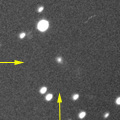
|
Now it is 16.6 mag (Jan. 16, Hidetaka Sato). It keeps observable at 15 mag for a long time in 2010.
Date(TT) R.A. (2000) Decl. Delta r Elong. m1 Best Time(A, h)
Jan. 23 17 12.85 12 22.3 5.419 4.937 56 16.1 3:30 (256, -2)
Jan. 30 17 19.19 13 20.3 5.326 4.915 60 16.0 3:40 (251, 4)
|

|
It brightened up to 13 mag and observed visually from 2007 to 2009. Due to the far distance, it is bright as 14.9 mag still now (Jan. 15, Ken-ichi Kadota). It will be observable in good condition again until spring.
Date(TT) R.A. (2000) Decl. Delta r Elong. m1 Best Time(A, h)
Jan. 23 13 21.32 35 55.7 7.200 7.637 112 16.1 3:30 (202, 15)
Jan. 30 13 18.09 36 47.6 7.150 7.669 118 16.1 3:40 (193, 17)
|
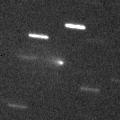
|
It brightened up to 11 mag in outburst in 2003. However, it does not seem to be so bright in this apparition. Now it is 16.3 mag (Jan. 2, Ken-ichi Kadota). It will be observable in good condition in winter. But it seems to brighten only up to 16 mag.
Date(TT) R.A. (2000) Decl. Delta r Elong. m1 Best Time(A, h)
Jan. 23 1 13.94 15 19.6 1.175 1.398 80 16.1 20:52 (123, 16)
Jan. 30 1 34.23 16 33.3 1.194 1.382 78 16.1 20:45 (124, 15)
|
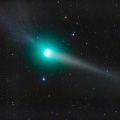
|
It passed near by the earth in late February in 2009, and it reached up to 4.9 mag (Feb. 23, Juan Jose Gonzalez). Now it is 16.2 mag (Dec. 22, R. Garcia). It will be low in the evening sky at 17-18 mag in spring.
Date(TT) R.A. (2000) Decl. Delta r Elong. m1 Best Time(A, h)
Jan. 23 4 46.78 20 30.6 4.129 4.822 130 16.1 20:52 (175, 34)
Jan. 30 4 41.03 20 22.8 4.300 4.889 121 16.2 20:45 (168, 34)
|
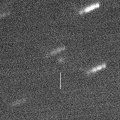
|
Now it is 17.3 mag (Jan. 16, Ken-ichi Kadota). It will be bright as 14-15 mag in spring. It keeps observable for a long time until September when it becomes fainter than 18 mag.
Date(TT) R.A. (2000) Decl. Delta r Elong. m1 Best Time(A, h)
Jan. 23 13 42.62 -17 56.2 1.628 1.938 92 16.9 3:30 (246, 58)
Jan. 30 13 56.29 -19 32.6 1.533 1.905 95 16.7 3:40 (242, 63)
|
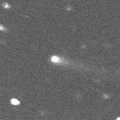
|
Now it is 15.9 mag (Dec. 18, Ken-ichi Kadota). This comet tends to brighten after the perihelion passage. It will be observable at 16 mag in 2010 and 2011. It is brighter than this ephemeris recently.
Date(TT) R.A. (2000) Decl. Delta r Elong. m1 Best Time(A, h)
Jan. 23 4 19.93 23 16.7 2.522 3.183 124 16.9 20:52 (169, 31)
Jan. 30 4 21.07 23 11.0 2.605 3.183 117 16.9 20:45 (163, 30)
|
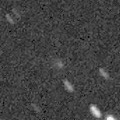
|
Now it is 16.9 mag (Jan. 16, Ken-ichi Kadota). It keeps observable at 17 mag in good condition for a while. It will be fainter than 18 mag in June.
Date(TT) R.A. (2000) Decl. Delta r Elong. m1 Best Time(A, h)
Jan. 23 1 59.33 12 12.5 1.533 1.811 89 17.0 20:52 (129, 26)
Jan. 30 2 8.96 14 10.7 1.567 1.778 85 17.0 20:45 (128, 23)
|
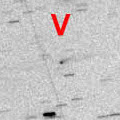
|
Now it is 17.9 mag (Jan. 19, W. Hasubick). It will be fainter than 18 mag in March.
Date(TT) R.A. (2000) Decl. Delta r Elong. m1 Best Time(A, h)
Jan. 23 11 12.72 19 15.0 1.367 2.209 139 17.3 3:05 (180, 36)
Jan. 30 11 9.12 20 46.0 1.363 2.254 146 17.4 2:34 (180, 34)
|
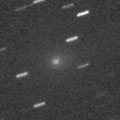
|
Fading slowly. Now it is 17.8 mag (Jan. 24, Ken-ichi Kadota). It keeps observable in good condition until February when it becomes fainter than 18 mag.
Date(TT) R.A. (2000) Decl. Delta r Elong. m1 Best Time(A, h)
Jan. 23 9 56.70 7 52.5 1.825 2.743 153 17.4 1:49 (180, 47)
Jan. 30 9 49.66 8 7.8 1.841 2.796 162 17.5 1:15 (180, 47)
|
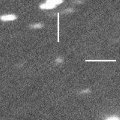
|
Now it is 18.0 mag (Dec. 19, Ken-ichi Kadota). It keeps observable at 17 mag for a long time from 2010 to 2012.
Date(TT) R.A. (2000) Decl. Delta r Elong. m1 Best Time(A, h)
Jan. 23 2 19.24 17 16.1 8.415 8.566 95 17.5 20:52 (136, 25)
Jan. 30 2 17.55 17 11.7 8.529 8.552 88 17.5 20:45 (132, 22)
|
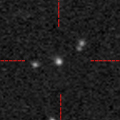
|
Now it is 17.9 mag (Jan. 24, Ken-ichi Kadota). It keeps observable at 17 mag until spring. It will reach up to 14 mag and will be observable in good condition in the next winter.
Date(TT) R.A. (2000) Decl. Delta r Elong. m1 Best Time(A, h)
Jan. 23 7 55.84 73 27.4 4.021 4.668 125 17.5 23:43 (180,-18)
Jan. 30 7 26.73 72 39.6 3.999 4.620 123 17.5 22:46 (180,-18)
|

|
Now it is 18.4 mag (Jan. 13, Ken-ichi Kadota). It will be observable at 17.5 mag in good condition in early 2010 and early 2011.
Date(TT) R.A. (2000) Decl. Delta r Elong. m1 Best Time(A, h)
Jan. 23 5 18.12 20 46.7 2.780 3.567 137 17.8 21:07 (180, 34)
Jan. 30 5 16.35 20 54.5 2.846 3.560 129 17.8 20:45 (178, 34)
|
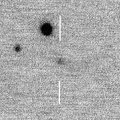
|
Now it is 17.4 mag (Jan. 8, Ken-ichi Kadota). It will be observable at 17.5 mag in good condition in winter.
Date(TT) R.A. (2000) Decl. Delta r Elong. m1 Best Time(A, h)
Jan. 23 9 57.72 34 29.7 2.139 3.053 153 17.8 1:50 (180, 21)
Jan. 30 9 53.18 35 9.8 2.128 3.062 157 17.8 1:18 (180, 20)
|

|
New periodic comet which brightened up to 14 mag in 2004 and 2005. It should be observable at 18 mag also around the aphelion. However, no observations have been reported since 2008 January. It seems to have faded out rapidly. Now it is fainter than 20.4 mag actually (Sept. 16, Leonid Elenin).
Date(TT) R.A. (2000) Decl. Delta r Elong. m1 Best Time(A, h)
Jan. 23 6 29.64 30 58.2 4.060 4.955 152 20.0 22:18 (180, 24)
Jan. 30 6 25.61 31 4.4 4.108 4.947 144 20.0 21:47 (180, 24)
|
|
![]()
 94P/Russell 4
94P/Russell 4 C/2006 OF2 ( Broughton )
C/2006 OF2 ( Broughton ) P/2009 Q4 ( Boattini )
P/2009 Q4 ( Boattini ) P/2009 T2 ( La Sagra )
P/2009 T2 ( La Sagra ) C/2008 N1 ( Holmes )
C/2008 N1 ( Holmes ) 74P/Smirnova-Chernykh
74P/Smirnova-Chernykh C/2007 G1 ( LINEAR )
C/2007 G1 ( LINEAR ) C/2008 Q3 ( Garradd )
C/2008 Q3 ( Garradd ) C/2008 FK75 ( Lemmon-Siding Spring )
C/2008 FK75 ( Lemmon-Siding Spring ) C/2005 L3 ( McNaught )
C/2005 L3 ( McNaught ) 157P/Tritton
157P/Tritton C/2007 N3 ( Lulin )
C/2007 N3 ( Lulin ) P/2010 A5 ( LINEAR )
P/2010 A5 ( LINEAR ) 203P/2008 R4 ( Korlevic )
203P/2008 R4 ( Korlevic ) P/2010 A3 ( Hill )
P/2010 A3 ( Hill ) 230P/2009 U6 ( LINEAR )
230P/2009 U6 ( LINEAR ) 64P/Swift-Gehrels
64P/Swift-Gehrels C/2008 S3 ( Boattini )
C/2008 S3 ( Boattini ) C/2010 B1 ( Cardinal )
C/2010 B1 ( Cardinal ) 31P/Schwassmann-Wachmann 2
31P/Schwassmann-Wachmann 2 232P/2009 W1 ( Hill )
232P/2009 W1 ( Hill ) P/2004 F3 ( NEAT )
P/2004 F3 ( NEAT )![]()



































